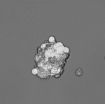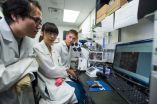(Press-News.org) Medford/Somerville, Mass--Researchers in human genetics have known that long nucleotide repeats in DNA lead to instability of the genome and ultimately to human hereditary diseases such Freidreich's ataxia and Huntington's disease.
Scientists have believed that the lengthening of those repeats occur during DNA replication when cells divide or when the cellular DNA repair machinery gets activated. Recently, however, it became apparent that yet another process called transcription, which is copying the information from DNA into RNA, could also been involved.
A Tufts University study published online on November 20 in the journal "Cell Reports" by a research team lead by Sergei Mirkin, the White Family Professor of Biology at Tufts' School of Arts and Sciences, along with former graduate student Kartick Shah and graduate students Ryan McGuity and Vera Egorova, explores the relationship between transcription and the expansions of DNA repeats. It concludes that the active transcriptional state of a DNA segment containing a DNA repeat predisposes it for expansions. The print version of the study will be published on December 11.
"There are a great many simple repetitive motifs in our DNA, such as GAAGAAGAA or CGGCGGCGG," says Mirkin. "They are stable and cause no harm if they stay short. Occasionally, however, they start lengthening compulsively, and these uncontrollable expansions lead to dramatic changes in genome stability, gene expression, which can lead to human disease."
In their study, the researchers used baker's yeast to monitor the progress and the fundamental genetic machineries for transcription, replication and repair in genome functioning.
"The beauty of the yeast system is that it provides one with a practically unlimited arsenal of tools to study the mechanisms of genome functioning," says Mirkin. "We created genetic systems to track down expansions of the repeats that were positioned in either transcribed or non-transcribed parts of reporter genes."
After measuring the rate of repeat expansions in all these cases, the authors found that a repeat can expand under the condition when there is practically no transcription, but the likelihood of the expansion process is drastically (10-fold) higher when the reporter is transcriptionally active.
Surprisingly, however, transcription machinery does not need to physically pass through the repeat to stimulate its expansion. Thus, it is the active transcription state of the repeat-containing DNA segment, rather than RNA synthesis through the repeat that promotes expansions.
In the transcriptionally active state, DNA is packaged in chromatin more loosely than when it is transcriptionally inactive. More specifically, the density of nucleosomes along the transcribed DNA segment is significantly lower than that in the non-transcribed segment. This packaging of repetitive DNA within the transcribed areas gives much more room for DNA strand gymnastics, ultimately leading to repeat expansions.
Whatever the exact model, says Mirkin, the fact that expandable DNA repeats were always found in transcribed areas of our genome may not be that surprising after all.
INFORMATION:
This study was funded by NIH grants GM60987 and GM105473.
Shah et al., 2014, Cell Reports 9, 1-9
December 11, 2014
http://dx.doi.org/10.1016/j.celrep.2014.10.048
Tufts University, located on three Massachusetts campuses in Boston, Medford/Somerville, and Grafton, and in Talloires, France, is recognized among the Premier research universities in the United States. Tufts enjoys a global reputation for academic excellence and for the preparation of students as leaders in a wide range of professions. A growing number of innovative teaching and research initiatives span all Tufts campuses, and collaboration among the faculty and students in the undergraduate, graduate and professional programs across the university's schools is widely encouraged.
Researchers at the University of Leeds have shed light on a gene mutation linked to autistic traits.
The team already knew that some people with autism were deficient in a gene called neurexin-II. To investigate whether the gene was associated with autism symptoms, the Leeds team studied mice with the same defect.
They found behavioural features that were similar to autism symptoms, including a lack of sociability or interest in other mice.
Dr Steven Clapcote, Lecturer in Pharmacology in the University's Faculty of Biological Sciences, who led the study published ...
Flexible electronics have been touted as the next generation in electronics in various areas, ranging from consumer electronics to bio-integrated medical devices. In spite of their merits, insufficient performance of organic materials arising from inherent material properties and processing limitations in scalability have posed big challenges to developing all-in-one flexible electronics systems in which display, processor, memory, and energy devices are integrated. The high temperature processes, essential for high performance electronic devices, have severely restricted ...
Cancer stem cells are particularly difficult to eradicate and are at the heart of why it is so hard to more effectively treat cancer patients, as the post-treatment survival of cancer stem cells drives tumour recurrence, the systemic spread of cancer and, ultimately, treatment failure.
The researchers, based at the University's Institute of Cancer Sciences and the Cancer Research UK Manchester Institute - both part of the Manchester Cancer Research Centre - investigated the role of mitochondria which produce and release energy within cells. In this context, the new ...
CHICAGO (November 25, 2014) - New research shows providing detainees wash cloths treated with a skin cleanser could reduce the prevalence of Staphylococcus aureus (S. aureus) bacteria in U.S. jails. Researchers looked at the effect on transmission of S. aureus of using wash cloths treated with chlorhexidine gluconate (CHG) compared with wash cloths with only plain water in detainees at Dallas County Jail. The study was published in the December issue of Infection Control and Hospital Epidemiology, the journal of the Society for Healthcare Epidemiology of America (SHEA). ...
CHICAGO (November 25, 2014) - A new study finds a decrease in an emergent strain of methicillin-resistant S. aureus (MRSA) that is resistant to last line defense antibiotics. Researchers examined the prevalence of vancomycin-resistant Staphylococcus aureus (VRSA) infections in southeastern Michigan, where the majority of these infections have occurred in the U.S. The study is published in the December issue of Infection Control and Hospital Epidemiology, the journal of the Society for Healthcare Epidemiology of America (SHEA).
"Vancomycin is one of the few antimicrobial ...
With research and development costs for many drugs reaching well into the billions, pharmaceutical companies want more than ever to determine whether their drugs already at market have any hidden therapeutic benefits that could warrant putting additional indications on the label and increase production.
Such repurposing of drugs requires evidence of efficacy, and to find candidate drugs for randomized controlled repurposing trials, investigators can use computer simulation and scans of health care billing data, in addition to in vitro and in vivo testing.
A study led ...
Parasites use Trojan horse subterfuge to suppress the immunity of their victims when causing infection, according to a study.
The finding, which shows a new trick parasites can play, paves the way to possible treatments for infectious diseases and allergies.
Scientists have shown that parasites are able to secrete tiny sealed packages of genetic material into the cells of their victims, in order to suppress the immune response to infection.
The packages, known as vesicles, mimic those that are produced naturally in most organisms to carry out everyday functions such ...
(Boston)-- In the largest study of the genetics of memory ever undertaken, an international researcher team including scientists from Boston University School of Medicine (BUSM), have discovered two common genetic variants that are believed to be associated with memory performance. The findings, which appear in the journal Biological Psychiatry, are a significant step towards better understanding how memory loss is inherited.
Longer life spans and the increased prevalence of memory impairment and dementia world-wide underscore the critical public health importance of ...
BUFFALO, N.Y. - A new hybrid vehicle is under development.
Its performance isn't measured by the distance it travels, but rather the delivery of its cargo: vaccines that contain genetically engineered DNA to fight HIV, cancer, influenza and other maladies.
Described recently in the Proceedings of the National Academy of Sciences, the technology is a biomedical advancement that could help unleash the potential of DNA vaccines, which despite two decades of research, have yet to make a significant impact in the treatment of major illnesses.
"The technology that we're developing ...
There has been much recent debate on the benefits and risks of screening for breast cancer using BRCA1 and BRCA2 mutations in the general adult population. With an estimated 235,000 new breast cancer diagnoses each year in the U.S. and more than 40,000 deaths, it is clearly important to be able to determine which women may be genetically predisposed to breast cancer.
Glenn E. Palomaki, PhD, associate director of the Division of Medical Screening and Special Testing in the Department of Pathology and Laboratory Medicine at Women & Infants Hospital of Rhode Island has ...



